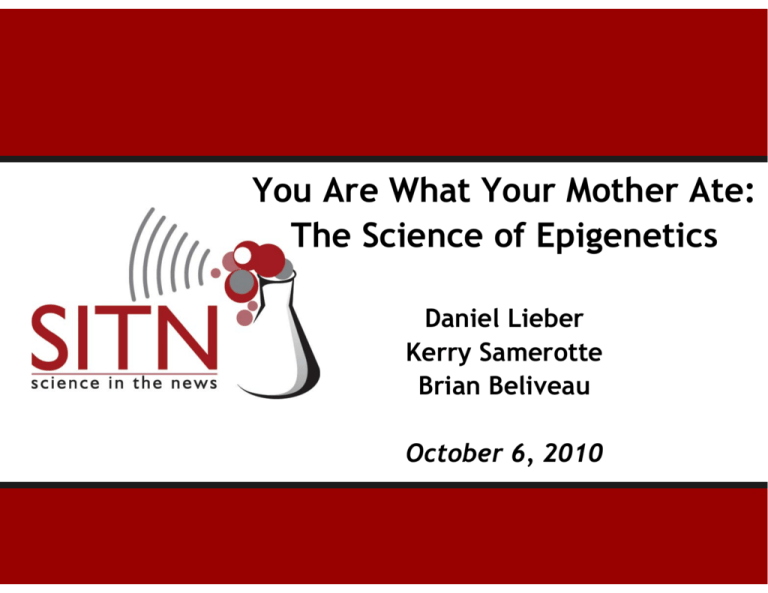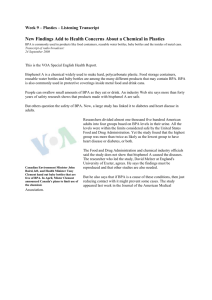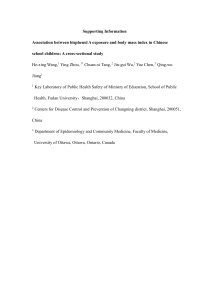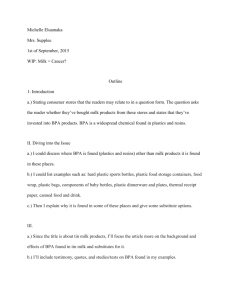You Are What Your Mother Ate: The Science of Epigenetics
advertisement

You Are What Your Mother Ate: The Science of Epigenetics Daniel Lieber Kerry Samerotte Brian Beliveau October 6, 2010 You are what your mother ate: Does your lifestyle alter your epigenetic marks? Kerry Samerotte The Time of Your Life Our epigenetic markings change over the course of our lives Images from creative commons users: gayleneallgood, ND Strupler, Anirudh Koul The Time of Your Life Do our lifestyles affect these changes? (The alternative is that these changes are set onto an unalterable course at birth) Images from creative commons users: gayleneallgood, ND Strupler, Anirudh Koul DNA is not Destiny Twins are genetically identical, but epigenetic differences accumulate over time. 3 year old twins Yellow = Same methylation level 50 year old twins Red/Green = Different methylation levels Images from: Chromosome: Fraga, PNAS 2005, San Francisco twins: creative commons user “igb”, Young twins: creative commons user “jk+too” What affects epigenetic modification? Diet? Behavior? Exposure to harmful substances? Images from: Athlete: Creative commons user Michael T, Nuts: christmasstockimages.com, Bisphenol: Wikipedia File:Bisphenol.jpg We don’t know! Diet? Behavior? Exposure to harmful substances? Images from: Athlete: Creative commons user Michael T, Nuts: christmasstockimages.com, Bisphenol: Wikipedia File:Bisphenol.jpg Beginning to Explore Current research is focused on early life Image from: cehwiedel.com Epigenetics in Early Animal Life Images from: http://www.niehs.nih.gov/research/supported/programs/envepi/index.cfm, wikipedia:File:Bienenkoenigin.jpg, creative commons user: Arcadiareptiles Of Mice and Methyl Remember these mice? They are genetically identical How can they be different colors? Images from: http://www.niehs.nih.gov/research/supported/programs/envepi/index.cfm Epigenetic Methylation Turns Genes Off Epigenetic modification alters which genes are on or off OFF ON vs. You Are What Your Mother Ate This mouse’s mother ate a typical diet This mouse’s mother ate a high methyl diet Methylation stopped the yellow “agouti” gene from being expressed! Identical DNA! H33C H33C H33C This gene confers Yellow coat color Yellow “agouti” gene Images from: http://www.niehs.nih.gov/research/supported/programs/envepi/index.cfm Yellow “agouti” gene The Queen Stands Alone Worker and queen bees are genetically identical Worker Bees Queen Bee Social insects: Only the queen can reproduce How? Ovary development genes are methylated in workers! Images from wikipedia File:Weiselzellen 68a.jpg, File:Bienenkoenigin.jpg A Diet Fit for Queens Worker Bees Queen Bee Fed honey Fed “royal jelly” By default, ovary genes are methylated Royal jelly prevents methylation of DNA Workers cannot reproduce Ovary genes expressed and queens emerge! Images from wikipedia File:Weiselzellen 68a.jpg, File:Bienenkoenigin.jpg On or Off? Mouse example: diet added methyl groups and turned a gene off Default state is unmethylated Bee example: diet removed methyl groups and turned genes on Default state is methylated Whether methylation is beneficial or detrimental depends on the particular gene and on the environment Images from: http://www.niehs.nih.gov/research/supported/programs/envepi/index.cfm, wikipedia:File:Bienenkoenigin.jpg, All You Need is Love Maternal behavior can also have epigenetic consequences Rats receiving good maternal care are more resilient to stress. -increased stress hormone receptors (glucocorticoids) -more willingly eat novel foods -explore new environments Nature or Nurture? Images from creative commons user: Arcadiareptiles The Switch High handling, low stress mom Low handling, high stress mom If stress is genetic, offspring will have same stress level as biological parent If stress is environmental, offspring will have same stress level as foster parent Images from: http://www.clker.com/clipart-rat-3.html The Switch High handling, low stress mom Low handling, high stress mom If stress is genetic, offspring will have same stress level as biological parent If stress is environmental, offspring will have same stress level as foster parent Images from: http://www.clker.com/clipart-rat-3.html The Switch High handling, low stress mom Low handling, high stress mom Switch offspring If stress is genetic, offspring will have same stress level as biological parent If stress is environmental, offspring will have same stress level as foster parent Images from: http://www.clker.com/clipart-rat-3.html The Switch High handling, low stress mom Low handling, high stress mom Switch offspring If stress is genetic, offspring will have same stress level as biological parent If stress is environmental, offspring will have same stress level as foster parent Images from: http://www.clker.com/clipart-rat-3.html The Switch High handling, low stress mom Low handling, high stress mom Switch offspring If stress is genetic, offspring will have same stress level as biological parent If stress is environmental, offspring will have same stress level as foster parent Images from: http://www.clker.com/clipart-rat-3.html Nurture! (but how?) Differences in the amount of glucocorticoid receptor proteins These prevent overproduction of stress hormones Mice with absent moms: Less glucocorticoid receptor Gene encoding glucocorticoid receptor is methylated & bound by histones Mice with attentive moms: More glucocorticoid receptor Gene encoding glucocorticoid receptor has decreased methylation and histones Nurture! (but how?) Differences in amount of glucocorticoid receptor proteins These prevent overproduction of stress hormones Maternal care removes epigenetic modifications to turn glucocorticoid receptor gene on What causes epigenetic modification? Diet? Behavior? Methyl source in mice Parental care in rats Royal Jelly in bees What about toxins? Images from: http://www.niehs.nih.gov/research/supported/programs/envepi/index.cfm, wikipedia:File:Bienenkoenigin.jpg, creative commons user: Arcadiareptiles Environmental Toxins Canada Likely to Label Plastic Ingredient “Toxic: Invisib le Dan ger? Parent s L ook I nside t he Lun c hbox. F.D.A. to Reconsider Plastic Bottle Risk d r a H A i c i t s a Pl a R s g n i is d r Ha s n o i t s e u Q That Plastic Baby Bottle Canada Takes Steps to Ban Most Plastic Baby Bottles New York Times Headlines BPA Plastics: An Intense Debate In a Feast of Data on BPA Plastic, No Final Answer Latest New York Times Headline The BPA Basics BPA = Bisphenol A There are various health concerns We’ll only talk about the possible epigenetic effects highlighted in a 2007 study by Dolinoy and colleagues from PNAS Caveats: Single study Less than 100 mice High concentrations of BPA The BPA Hypothesis Bisphenol A REMOVES DNA methylation This alters patterns of gene expression Image and data from: Dolinoy PNAS 2007 Experimental Design Image and data from: Dolinoy PNAS 2007 Experimental Design Mother mice Fed a typical diet Mother mice Fed a BPA rich diet 60 offspring 72 offspring Image and data from: Dolinoy PNAS 2007 Experimental Design Mother mice Fed a typical diet Mother mice Fed a BPA rich diet Question: How many are yellow? (Methylation removed) 60 offspring Image and data from: Dolinoy PNAS 2007 72 offspring Experimental Design Mother mice Fed a typical diet Mother mice Fed a BPA rich diet 60 offspring 72 offspring Mice fed 200x more BPA per kg than the Maximum EPA Recommended Dose: 10mg/kg bodyweight > 0.05mg/kg Mice fed 10,000x more BPA per kg than average human intake: 10mg/kg bodyweight > 0.00011mg/kg Image and data from: Dolinoy PNAS 2007 Coat Color Data Percent of Offspring Mice from mothers fed diets rich in BPA vs. no BPA Control Fed Image and data from: Dolinoy PNAS 2007 BPA Fed Epigenetic Data Nine sites commonly methylated on yellow “agouti” gene AGATACCCGCTCCAGATCGATACAGCTTATACGCTCACGATAGCTAGCATCA GCTCTCACGACCTCGATCCAGACTAGATCGAAGATACCCGCTCCAGATCGAT ACAGCTTATACGCTCACGATAGCTAGCATCAGCTCTCACGACCTCGATCCAG ACTAGATCGAAGATACCCGCTCCAGATCGATACAGCTTATACGCTCACGATA GCTAGCATCAGCTCTCACGACCTCGATCCAGACTAGATCGAAGATACCCGCT CCAGATCGATACAGCTTATACGCTCACGATAGCTAGCATCAGCTCTCACGAC CTCGATCCAGACTAGATCGAGATACCCGCTCCAGATCGATACAGCTTATACG CTCACGATAGCTAGCATCAGCTCTCACGACCTCGATCCAGACTAGATCGAAG ATACCCGCTCCAGATCGATACAGCTTATACGCTCACGATAGCTAGCATCAGC TCTCACGACCTCGATCCAGACTAGATCGA Representative DNA sequence adapted from: Dolinoy PNAS 2007 Epigenetic Data Hypothesis: BPA removes methylation at these nine sites AGATACCCGCTCCAGATCGATACAGCTTATACGCTCACGATAGCTAGCATCAGCTCTCACGACCTCGATC CAGACTAGATCGAAGATACCCGCTCCAGATCGATACAGCTTATACGCTCACGATAGCTAGCATCAGCTCT CACGACCTCGATCCAGACTAGATCGAAGATACCCGCTCCAGATCGATACAGCTTATACGCTCACGATAG CTAGCATCAGCTCTCACGACCTCGATCCAGACTAGATCGAAGATACCCGCTCCAGATCGATACAGCTTAT ACGCTCACGATAGCTAGCATCAGCTCTCACGACCTCGATCCAGACTAGATCGAGATACCCGCTCCAGAT CGATACAGCTTATACGCTCACGATAGCTAGCATCAGCTCTCACGACCTCGATCCAGACTAGATCGAAGAT ACCCGCTCCAGATCGATACAGCTTATACGCTCACGATAGCTAGCATCAGCTCTCACGACCTCGATCCAG ACTAGATCGA Percent of mice with given site methylated Control Diet Image adapted from: Dolinoy PNAS 2007 BPA diet Can proper nutrition combat toxins? Percent of mice Extra methyl diet increased methylation: More brown mice High BPA diet decreased methylation: More yellow mice What about BPA + extra methyl? Control Image adapted from: Dolinoy PNAS 2007 BPA BPA + Extra Methyl Conclusions about BPA Although intriguing, this study is not conclusive evidence that BPA is unsafe at current levels. What’s next: Caveats: More research… Not enough mice that goes for everything Multiple effects of BPA Single lab’s results Diet? Quantity of BPA Behavior? Toxins? ? Dolinoy PNAS 2007 Summary There is mounting evidence that epigenetic modifications like methylation and histone binding are affected by lifestyle and environment vs. Thank you! Questions?







